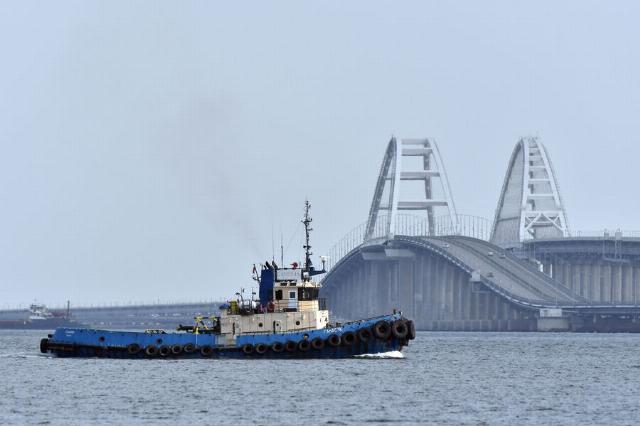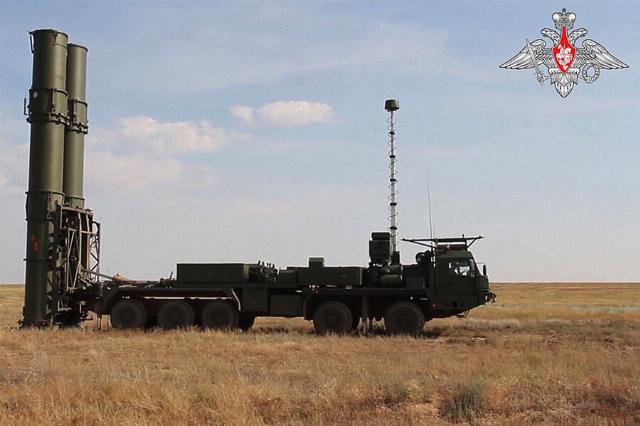Colonel Khodarenok: Russia needs sea-based S-500 air defense systems
Russia has deployed its first anti-aircraft missile regiment equipped with the S-500 Prometheus air defense system to protect the Crimean Bridge, the American MWM reported. What are the advantages of the latest Russian air defense system, what kind of development it can receive and how the fleet is connected with it - in the material of the military observer Gazeta.Ru" by Mikhail Khodarenka.
Military Watch Magazine reported that the Russian Aerospace Forces deployed "their only regiment of S-500 long-range air defense systems to protect the bridge across the Kerch Strait connecting the Crimean peninsula with mainland Russia." According to the magazine, the structural elements of the S-500 anti-aircraft missile system appeared in the vicinity of Kerch.
MWM notes that the S-500 (also known as Prometheus and 55P6M Triumfator-M) is the world's first mobile surface-to-air system with anti-satellite and anti-missile capabilities with an air attack detection range of up to 800 km and a range of 600 km. The system, the publication believes, is capable of hitting targets flying at hypersonic speeds.
 |
| Crimean bridge. |
| Source: Konstantin Mikhalchevsky/RIA Novosti |
MWM journalists believe that by the mid-2020s, S-500 systems will cover large cities and strategic facilities in the Arctic and the Pacific Ocean.
The prospects of Prometheus
Indeed, the S-500 is currently in the final stage of testing. Its use will significantly strengthen the missile defense of the Central Industrial Region in terms of combating the means of aerospace attack: land-based and sea-based ballistic missile warheads, hypersonic cruise missiles and inter-medium aircraft (we are talking about systems capable of flying both in the atmosphere and near space).
In the course of further work on Prometheus, it is planned to create a missile defense system for the defense of both administrative and military facilities and naval bases located in the Kaliningrad Special Region, on the Kola Peninsula, in the Crimea, and in the Far East.
At the same time, the deployment of the new system involves a large amount of capital construction: the construction of launch sites, technological facilities, administrative and residential buildings. Certain difficulties in densely populated areas of the country may arise even with the allocation of land for the deployment of S-500 air defense systems.
Hence, the idea arose at the time: should we place the 55P6M Triumfator-M system on the ships of the Russian Navy, which would make it possible to create missile defense groups in a fairly short time?/Air defense in possible theaters of military operations? This is how this problem is largely solved in the West.
For example, NATO member countries and their allies (Japan, the Republic of Korea, Australia, as well as Spain and Norway) have more than 100 combat-ready surface ships equipped with the Aegis Combat information management System (BIOS).
It is a ship-based multifunctional combat system consisting of a network of lighting equipment and weapons of destruction. Aegis is capable of combating air and space attacks in almost all areas of the world Ocean. In addition, US Navy ships equipped with this system will be used as a naval component of the European Missile Defense System. In Russia, there are no analogues of surface ships equipped with the Aegis BIUS yet.
A mock-up destroyer
In 2015-2016, by order of the Navy, the cooperation of defense industry enterprises under the head role of JSC "Northern Design Bureau" (Russia's leading design bureau for the design of combat surface ships of various classes) developed a draft design for a new destroyer of the far sea and ocean zone - project 23560, development work "Leader", which was supposed to be equipped. a promising S-500 system.
However, the case, as they say, did not go well. Following the review of the Leader project, an analysis of the possibilities of fulfilling tactical and technical tasks, as well as due to the incompleteness of the development of the S-500 naval variant at that time, work on the project was stopped.
And when the full composition of the Prometheus became known and the system began to be embodied in metal, to acquire real dimensions and weights, it became clear that a promising destroyer simply would not pull the "five hundred" either in displacement, size, or power of the ship's main power plant. That is, after placing the Triumphator aboard the Leader, the ship could easily sink under the weight of the anti-aircraft missile system right at the pier. In general, the destroyer project was postponed indefinitely, and all work in this area was suspended.
In addition, the sailors, I must say, were not very interested in the idea of combating the means of an aerospace attack. "This is not a typical task for the navy, but we have enough problems of our own," the admirals insisted.
"Trident" will not have a sweet time
And what advantages can the presence of a naval missile defense component give the Russian army? Quite a lot, to put it bluntly.
The inclusion of the naval component of missile defense in the groupings, in addition to increasing the overall potential, will ensure the conduct of reconnaissance and interception of launching intercontinental ballistic missiles (ICBMs) and submarine-launched ballistic missiles (SLBMs) in the active area when a ship equipped with the S-500 air defense system is located in neutral waters or in ports of friendly countries, and will also give a win. by the time of detection and interception of attacking targets.
In practice, it will look something like this. The active part of the trajectory of the American UGM-133A Trident II (Poseidon Trident) submarine-launched ballistic missile is approximately 170-190 seconds after launch from an underwater position. At this stage, the missile has a relatively low speed and the largest effective scattering surface (ESR) - and it is in this section of the flight path that it is most effective to shoot it down.
There is another important point: it is highly advisable to destroy the SLBM before the withdrawal of its warheads. Thus, the Trident II (D5) combat compartment can accommodate up to eight W88 warheads with a capacity of 475 kilotons or up to 14 W76 warheads with a capacity of 100 kilotons. In order to shoot them down after breeding, you will have to spend from 16 to 28 expensive anti-missiles - two in turn for each combat unit. You won't get enough anti-missiles that way. And destroying a missile in the active part of the trajectory, immediately after launch, will require a maximum of two anti-missiles. In addition, when firing warheads over the territory of their country, there is a real risk of radioactive contamination of the area.
Also, the presence of a naval missile defense component is becoming increasingly important to ensure the country's national security in the context of a further build-up of NATO forces near Russia's borders, including their direct involvement in the armed conflict in Ukraine.
The opinion of the author may not coincide with the position of the editorial board.
Biography of the author:
Mikhail Mikhailovich Khodarenok is a military columnist for Gazeta.Ru", retired colonel.
He graduated from the Minsk Higher Engineering Anti-Aircraft Missile School (1976), the Military Air Defense Command Academy (1986).
Commander of the S-75 anti-aircraft missile division (1980-1983).
Deputy commander of the anti-aircraft missile regiment (1986-1988).
Senior Officer of the General Staff of the Air Defense Forces (1988-1992).
Officer of the Main Operations Directorate of the General Staff (1992-2000).
Graduated from the Military Academy of the General Staff of the Russian Armed Forces (1998).
Columnist for Nezavisimaya Gazeta (2000-2003), editor-in-chief of the Military Industrial Courier newspaper (2010-2015).
Mikhail Khodarenok

